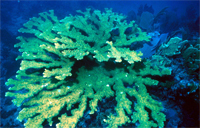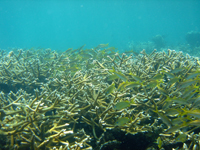NOAA Proposes Critical Habitat for Threatened Elkhorn and Staghorn Corals
February 7, 2008

Elkhorn coral.
+ High Resolution (Credit: NOAA)
Elkhorn and staghorn corals, listed as threatened under the Endangered Species Act in May 2006, will benefit from the designation of newly proposed critical habitat. NOAA is seeking public comment on its proposal, which identifies approximately 4,931 square miles of marine habitat in Florida, Puerto Rico, and the U.S. Virgin Islands as critical habitat for the threatened corals – a requirement of the ESA.
Elkhorn and staghorn corals are fast-growing, branching corals that were once found throughout the Caribbean. It is estimated that more than 90 percent of these corals have been lost because of disease, coral bleaching, and tropical storm damage. Further, the overall deterioration of coral reef habitats appears to be compromising the species’ ability to reproduce, making this proposed designation even more important.
“Designating critical habitat for these species is important because it informs the public of areas that are crucial to the conservation of the species and identifies where conservation actions will be most effective,” said Dr. Roy Crabtree, NOAA Fisheries Service’s Southeast regional administrator. “The designation will also help ensure that federal government activities are planned to avoid destruction of these important habitats.”
Areas designated as critical habitat contain features that are not directly protected under existing laws but are essential to the conservation of the species. For these threatened corals that includes natural hardbottom and dead coral skeletons in water depths less than 30 meters. Protecting these features will maximize the potential for successful recruitment and population growth.
The areas proposed for designation include shallow, nearshore areas in:
- South Florida, from Palm Beach County through the Dry Tortugas, covering approximately 3,301 square miles;
- Puerto Rico, covering approximately 1,383 square miles;
- St. John/St. Thomas, covering approximately 121 square miles; and
- St. Croix, covering approximately 126 square miles.

Staghorn coral.
+ High Resolution (Credit: NOAA)
While the designation of critical habitat does not affect land ownership or establish a refuge, wilderness, reserve, preserve, or other conservation area, it does require that federal agencies that undertake, fund, or permit activities that may affect critical habitat to consult with NOAA's Fisheries Service to ensure actions do not adversely modify or destroy critical habitat.
Additionally, areas supporting military operations, training, and readiness, associated with Naval Air Station Key West in the Florida Keys are proposed for exclusion due to national security impacts. Further, man-made structures such as boat ramps, docks, and pilings and maintained channels or marinas are not included in the proposed critical habitat.
NOAA is seeking input from the public on this proposed designation through May 6, 2008. Comments may be submitted, with RIN 0648-AV35 included the subject line, by any of the following methods:
- Electronic: Federal eRulemaking Portal
- Fax: 727-824-5309, Attention: Jennifer Moore
- Mail: Assistant Regional Administrator, Protected Resources Division, NMFS, Southeast Regional Office, 263 13th Avenue South, St. Petersburg, FL 33701
Oral and written comments will also be accepted at the following scheduled public hearings:
- Tuesday, March 4, 2008, 7 p.m. to 9 p.m., IGFA Events Hall, 300 Gulf Stream Way, Dania Beach, Florida.
- Wednesday, March 5, 2008, 7 p.m. to 9 p.m., Marathon Government Center, 2798 Overseas Highway, Marathon, Florida.
- Tuesday, March 11, 2008, 6 p.m. to 8 p.m., Administration and Conference Center (ACC) 1st Floor Conference Room, University of the Virgin Islands, #2 John Brewer's Bay, St. Thomas, USVI. Simulcast Location on St. Croix: The Great Hall, Room #134, University of the Virgin Islands, RR 1, Box 10000 Kingshill, St. Croix, USVI.
- Wednesday, March 12, 2008, 7 p.m. to 9 p.m., 4th Floor Conference Room, Environmental Building, Cruz Matos, State Road #838, km. 6.3, Sector El Cinco, Rio Piedras, Puerto Rico.
The National Oceanic and Atmospheric Administration, an agency of the U.S. Commerce Department, is dedicated to enhancing economic security and national safety through the prediction and research of weather and climate-related events and information service delivery for transportation, and by providing environmental stewardship of our nation's coastal and marine resources. Through the emerging Global Earth Observation System of Systems (GEOSS), NOAA is working with its federal partners, more than 70 countries and the European Commission to develop a global monitoring network that is as integrated as the planet it observes, predicts and protects.
